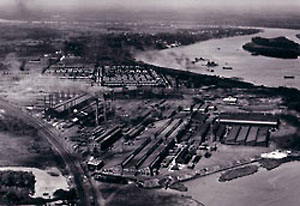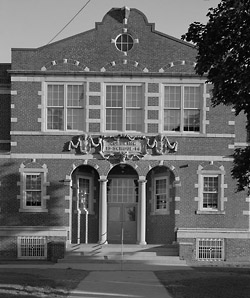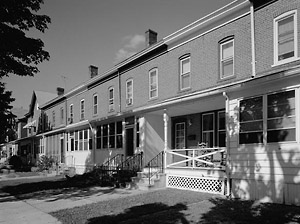Roebling, NJ | View Map
Roebling Village

1924 aerial photograph of Kinkora Works and Roebling Village. Credit: Victor Dallin Aerial Survey collection, Hagley Museum and Library
In 1904, the Trenton-based John A. Roebling’s Sons Company launched two ambitious projects—a large new steel and wire manufacturing plant and the creation of a new town adjacent to the plant. They chose a site along the Delaware River near the small railway village of Kinkora. The lack of available housing and services for the large number of workers needed for the new industry in this rural area posed an immediate problem, so Roebling decided to build a complete modern town for its employees.

1997 photograph of main entrance (north façade) of the Roebling public school built in 1914 for grades 1-8. The Roebling Company contributed a substantial portion of the construction costs. Credit: Library of Congress, Historic American Engineering Record. Photograph by Joseph Elliott
Company president Charles Roebling designed the new village, which is organized on a modified grid pattern and intersected by two parkways. One of these, Main Street, led to the gatehouse of the new Kinkora Works. Roebling was designed as a self-contained community and was owned by the company. The new town had a full range of commercial buildings, a school, health care facilities, a library, and hotels. The company also built an assembly hall, park, athletic fields, and recreational center, among other amenities. The size and arrangement of the well-constructed brick residences with slate roofs reflected the employee hierarchy. “Foreign laborers” lived in blocks of two-story four-room row houses near the plant. For skilled workers, the company built comfortable two-story detached cottages. Supervisors and managers lived in eleven-room detached houses overlooking the park and the river. There were also three hotels to house single employees. By 1921, the company had built 767 homes here for a population of some 4,000 and invested more than $1.5 million dollars in the town. The number of employees continued to grow; by the late 1920s less than half of the Kinkora employees lived in Roebling and there was a waiting list for accommodations in the village.

Row houses on Third Avenue, 1997. Row houses like these were designated for foreign laborers. Credit: Library of Congress, Historic American Engineering Record. Photograph by Joseph Elliott
The Roebling Company operated within a competitive industry and its new factory town was designed to attract and retain a skilled workforce and avoid labor disputes. The company offered attractive wages and affordable rents. It provided water, sewage, electricity, and regular maintenance at no charge. Roebling drew its workforce for the Kinkora Works from many countries, but the majority came from central and Eastern Europe.
The Roebling Company was sold in 1953 to Colorado Fuel and Iron. After CF&I was sold, the Kinkora plant closed in 1974. New owners failed to restart production there, and the plant closed for good in 1982. As part of the remediation agreement for the Roebling Company superfund site, the main gatehouse to the plant was rehabilitated and houses a museum about the community. Roebling Village is listed in the National Register of Historic Places.
The Roebling Village Inn

Roebling Inn with view down Riverside Avenue. c.1920s. Credit: Trentoniana Collection, Trenton Public Library
The Roebling Village Inn is a key contributing building in the Roebling Historic District, which is listed in the National Register of Historic Places.
Built in 1904, the Inn was the first permanent building constructed on the Kinkora site and provided temporary housing for the builders of the new plant. It became the social center for the village and was the only establishment serving alcohol. Located on Riverside Drive opposite the town park, the two and one half story brick building was designed in the fashionable Colonial Revival style with prominent dormers and a wide veranda on three sides. The first floor contained a wide central hall with attractively decorated public rooms on both sides and a kitchen and storage area at the rear. The original detached carriage house has also survived.
For more information:
- www.roeblingmuseum.org
- www.capitalcentury.com/1905.html
- www.nationalregisterofhistoricplaces.com/nj/Burlington/state.html
- www.burlingtoncountyhistoricalsociety.org
- www.njtransit.com
Banner art: Main (#1) gate to Kinkora Works, c.1920 The gatehouse has been restored as part of the environmental remediation at the plant site and is now a museum. Credit: The Blue Center, Trentoniana Collection, Trenton Public Library






